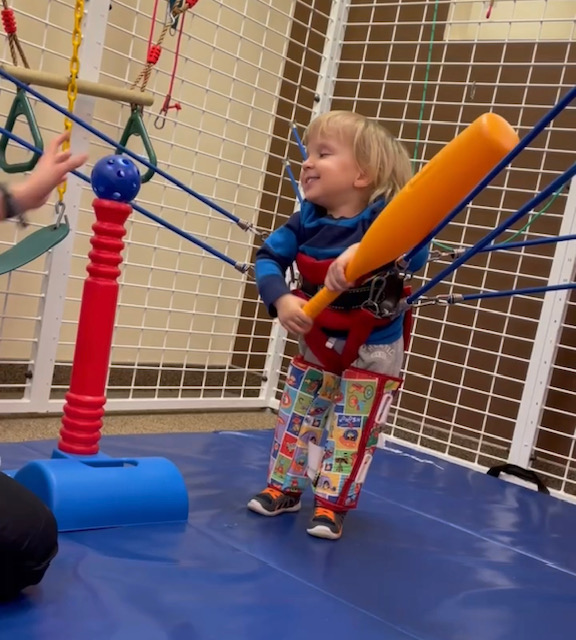

- Call 908 543 4390
- Email
- Dr.Joni Redlich PT,DPT


If you have a child who has difficulty with social skills and I asked you what kind of therapy could help your child develop these skills, what would you say?
I can guarantee physical therapy wouldn’t be on that list. Not even on the bottom of the list. Read more
“My son can’t keep up with his twin.”
“My daughter is always tripping and gets frustrated.”
“We finally got answers as to why my child is delayed, but now what?”
Do these concerns sound familiar to you? Have you been worried about your child and wondering where you might find answers and help? If so, you’ve come to the right place! Let’s start by answering the question-
What is a Pediatric Physical Therapist and Who Do They Help?
Pediatric Physical therapists (PTs) are licensed health professionals who have specialized knowledge and experience in the unique aspects of working with children and their families to improve motor development, independence, fitness and active participation in the family and in the community. Pediatric PTs work with children from birth through adolescence and participate on teams with other specialists, including physicians, occupational therapists and speech therapists.
They work with children to improve their brain-body connection, balance, strength, body awareness, coordination, and movement skills from crawling and walking to jumping and hopping. Pediatric physical therapists work with children to improve their sensory awareness and motor abilities. Improvement these skills can have a far ranging impact on the child beyond the movement itself, such as improving confidence, success in school, and social interaction.

Pediatric physical therapy often looks like play, but that is part of the magic! Pediatric physical therapists know how to engage the child with fun, share the joy of movement and combine that with the science of the brain and body. All these pieces come together to stimulate to new skills that the child can use in daily life at home, at school and in the community. New skills means new confidence and new success!
Read moreRe-posted from OUR Journey Thru Autism
“I’m doing it! I’m doing it!” yells an exuberant 8 year-old boy as he rides away from me on his bike. This young boy has a diagnosis of autism spectrum disorder and dyspraxia and was so frightened to just sit on his bike with training wheels 4 months ago that he held on to me for dear life. Today he rides away from me on a two-wheeled bike on his own and tomorrow he will ride with his brother through the neighborhood. Read more
For many of us who have a loved one with autism or work with children with autism, the vaccine debate is not something new. It is one that has been on my mind more over the last couple of years as I have done research to help me make decisions about how and when to vaccinate my daughter. It comes up frequently with parents of some of the children that I work with as they recount their stories and I have also treated children with “medically accepted” vaccination injuries. Read more
Playdough can be a great tool to strengthen the hands and for imaginary play. It can also be a great tool for increasing sensory awareness of the feet. It can also be used to challenge balance in standing like in this video, or it can be done in sitting too. Have fun trying it out!
Children toe-walk for various different reasons. Medical causes such as cerebral palsy and muscular dystrophy must be ruled out. Many children on the autism spectrum will also toe-walk. Additionally, children without any other diagnoses have been called idiopathic toe walkers. It is important to understand that toe-walking is a MOVEMENT problem, not just an ANKLE problem. This is why toe-walking can be challenging to parents and therapists alike. A whole body approach is needed to achieve great results! Read more
 As a pediatric physical therapist specializing in developmental disabilities, I have worked with a lot of children with autism spectrum disorders (ASD) over the past 10 years. After several months of physical therapy, I frequently saw how related areas of development, such as communication and social skills, would improve after addressing their motor deficits. Read more
As a pediatric physical therapist specializing in developmental disabilities, I have worked with a lot of children with autism spectrum disorders (ASD) over the past 10 years. After several months of physical therapy, I frequently saw how related areas of development, such as communication and social skills, would improve after addressing their motor deficits. Read more
Joni Daichman, MSPT, Tracy Cueli-Dutil, DPT and Roberto Tuchman, M.D.
Paper presented at the Geneva Centre Internal Symposium on Autism, Toronto, Canada (October 2002)
There has been an increased interest in the relationship between motor function, cognition, attention, language development and social communication disorders over the last few years.(Gillberg 1998; Landgren, Kjellman et al. 1998; Kadesjo and Gillberg 1999) The purpose of this brief report is to review the sensorimotor system as it applies to autism and related disorders. In addition we will discuss and highlight the motor clinical findings in children with autism and related disorders and provide preliminary data on our own clinical experience. Read more
Originally published in Autism Spectrum, Winter 2005
Movement is an integral part of our social, emotional, and physical lives. A 4-month old excitedly kicks her arms and legs in response to the funny face dad makes, so he does it again. An 8-month old will crawl to retrieve her favorite rattle, shake it to hear the sound it makes, and then look at mom to share the experience with her. An 18 month-old takes moms hand, walks her to the kitchen, and says “juice” while pointing to the refrigerator. As a child grows, the length and complexity of movement sequences become more sophisticated. Read more
The destruction in Haiti made me think about how children with autism and other disabilities are coping and surviving. I found the following article on a center for children in Haiti with developmental disabilities. The work they had done is so admirable, but now they are going to be starting over again.
